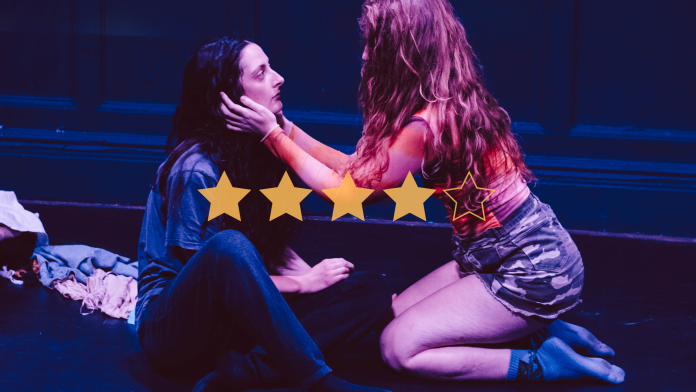★★★★✰
To be a queer woman is to live outside of the male gaze. A queer woman’s desire, desirability, and expression of them, is a path that many must forge alone. Only in the last couple of decades are we seeing mainstream movies, plays, and TV shows that showcase a woman’s desire for women in a way that is not villainised, derogatory, or laden with lazy stereotypes. Blue Is the Warmest Colour was the first film I ever saw that depicted a long-term lesbian relationship. Even then, their desire was choreographed with a male perspective behind it. Watching Reya Muller and Isabelle Tyner’s Semblance of a Woman, I saw a truly beautiful and poetic portrayal of queer desire between women.
The entire play takes place in Peggy’s room (Emma Chatel). Well, we never find out her real name. When a strange spirit crawls out from under her bed with no prior knowledge of the world, Peggy must teach her. The spirit names herself Gaia after flicking through Greek mythology book (Helen Baird), and gives Peggy her new name. Greek mythology plays an essential role in this play in a textured and considered way. Muller and Tyner’s incorporation of the myths of Pygmalion and Persephone both develops the plot and subverts their original meaning. The play begins with Peggy criticising Pygmalion’s wish to Aphrodite for his sculpture of the perfect woman to come to life. The play strongly rejects the male gaze.
It would be an injustice to omit the play’s visual beauty. The projections of rolling waves, old French films and American rom-coms added a much-needed whimsy to the set. Speaking of whimsy, Hana Sofia’s costume design is gorgeous, as Gaia appears in a bizarre gown of blankets and old clothes. Gaia chose a name as vast and absolute as the earth itself, so naturally her gown encompasses that all-ness that she wishes to put out into the world.
We are stuck in Peggy’s room for a reason. It is clear that she suffers from some sort of depression and suffers from night terrors and low mood. Teaching Gaia about makeup, romance, and the sea is sensually charged and a palpable intimacy develops. However, much like Hades’ underworld, Peggy wishes to keep Gaia inside, to never show herself to the real world. This is where Semblance of a Woman gets to the crux of the isolating experience of queer desire. Unrepresented and unable to reconcile within herself, Peggy feels resigned to reserving her desire in the comfort of her room. But Gaia, not jaded by the world’s hostility, is sure of herself and wants to experience the outside world without shame.
Many queer women will understand the conflict of deciding “the right time” to live openly with their desire. Gaia quickly picks up on Peggy’s wish to “fly away” from where she is. But Gaia would also be there, “wherever you flew to”. Peggy is eager to run away from who she is and where her desire leads her, but it is ultimately futile. Their more abstract conversations feel like the most tender passages of Sarah Kane while Kelly Thurston provides a physical edge. Semblance of a Woman is an enthralling Sapphic piece about the deepest crevices of a queer woman’s internal conflict.
Words by Elizabeth Sorrell
Support The Indiependent
We’re trying to raise £200 a month to help cover our operational costs. This includes our ‘Writer of the Month’ awards, where we recognise the amazing work produced by our contributor team. If you’ve enjoyed reading our site, we’d really appreciate it if you could donate to The Indiependent. Whether you can give £1 or £10, you’d be making a huge difference to our small team.
